Anions(Suppressor Method: SI-90, SI-50, SI-52 Columns)
As ion chromatography methods, two are well known: the suppressed method and the non-suppressed method. In the suppressed method, after the eluent has passed through the analytical column, ionic substances of which polarities are opposite of ionic substances in the sample are ridded by use of a special device(suppressor). By this method, the electro conductivity in the eluent can be largely decreased and highly sensitive analysis of anions is possible.
Shodex is offering several kinds of analytical column for the use of anion analysis by supressed method. It is highly recommended to use a line filter to obtain a stable beseline and a guard column to a have long service life of the main column.
Advantages of suppressed method.
1. Background conductivity is low.
(anion analysis: about 20 micro-S/cmFS)
2. Sensitivity is high. Detection sensitivity is several ppb and minimum sample concentration is about tens ppb.
3. Free from temperature fluctuation and stable analysis is possible.
Disadvantages of suppressed method.
The use of a suppressor is essential and the system is rather expensive.
(Shodex IC SI-90)
Please use this column with suppressor type ion chromatography system.
Anion standards were analyzed using IC SI-90 4E (a column for anions analysis). For general purpose, it is recommended to use 1.8mM Na2CO3 + 1.7mM NaHCO3 as the eluent. This eluent is best suited to the separation of typical 7 anions, F–,Cl–,NO2–,Br–,NO3–,PO43-,SO42-. Using the flow rate of 1.5 mL/min, seven anions can be analyzed within ten minutes. Use the column temperature of 25deg-C.
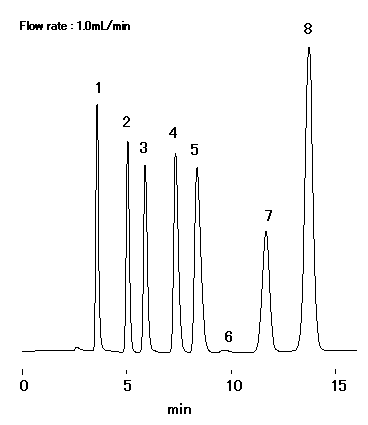
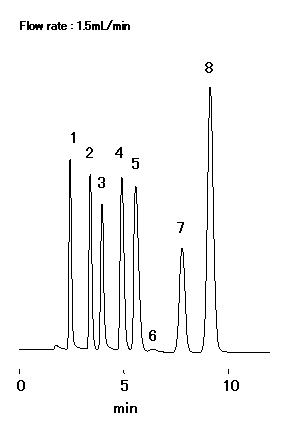
Sample : 20micro-L
1. F– (2ppm), 2. Cl– (3ppm), 3. NO2– (5ppm), 4. Br– (10ppm)
5. NO3– (10ppm), 6. HCO3– (300ppm), 7. PO43- (15ppm), 8. SO42- (15ppm)
(How to prepare the eluent)
(1) Put 19.08g of reagent grade Na2CO3 and 14.28g of reagent grade NaHCO3 into a 1 liter messflask.
(2) Dilute with purified water to make up a 1 liter solution.
(3) Dissolve the solution using an ultrasonic vibrator. When the solution volume decrease after the vibration, add pure water to make up exact 1 liter solution. This is the concentrated solution and can be stored for half year in a refregirator with stopper.
(4) When making the eluent, take 10ml of the concentrated solution and dilute with purified water to make up 1 liter solution. Pass the eluent through a 0.45micron membrane filter before use.
Column : Shodex IC SI-90 4E (4.0mmID*250mm) Eluent : 1.8mM Na2CO3+ 1.7mM NaHCO3 aq. Flow rate : 1.0mL/min or 1.5mL/min Detector : Suppressed conductivity Column temp. : Room temp. (25deg-C)
Please use this column with suppressor type ion chromatography system.
Anion standards were analyzed using IC SI-90 4E (a column for anions analysis). HS– is difficult to detect by conductivity. To separate and detect the above-mentioned anions, UV and CD detector are connected in series.
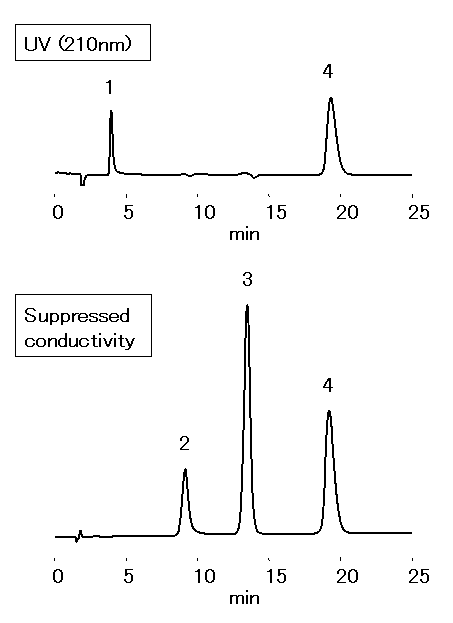
Sample : 50mg/L each, 20micro-L
1. HS–
2. SO32-
3. SO42-
4. S2O32-
Column : Shodex IC SI-90 4E (4.0mmID*250mm) Eluent : 1mM Na2CO3 + 4mM NaHCO3 + 5% Acetone Flow rate : 1.5mL/min Detector : UV(210nm) + Suppressed conductivity Column temp. : 25deg-C
Please use this column with suppressor type ion chromatography system.
Mineral water for drinking was analyzed using IC SI-90 4E (a column for anions analysis).
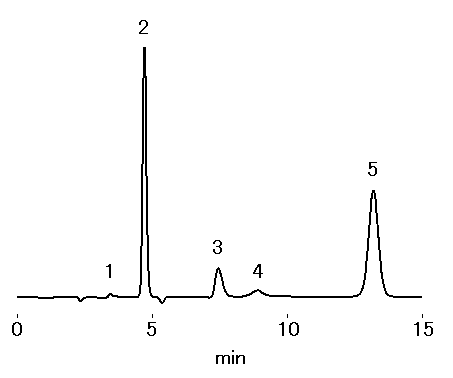
Sample : Mineral water(Water), 20micro-L
1. F–
2. Cl–
3. NO3–
4. HCO3–
5. SO42-
Column : Shodex IC SI-90 4E (4.0mmID*250mm) Eluent : 1.8mM Na2CO3 + 1.7mM NaHCO3 aq. Flow rate : 1.0mL/min Detector : Suppressed conductivity Column temp. : 25deg-C
Please use this column with suppressor type ion chromatography system.
Low concentration anion standards were analyzed using IC SI-90 4E (a column for anions analysis).
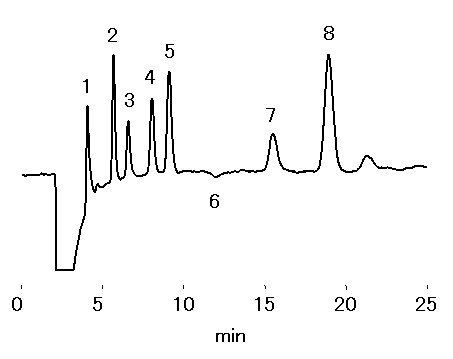
Sample : 100micro-L
1. F– 2micro-g/L
2. Cl– 3micro-g/L
3. NO2– 5micro-g/L
4. Br– 10micro-g/L
5. NO3– 10micro-g/L
6. HCO3– (system peak)
7. PO43- 15micro-g/L
8. SO42- 15micro-g/L
Column : Shodex IC SI-90 4E (4.0mmID*250mm) Eluent : 1mM Na2CO3 + 4mM NaHCO3 aq. Flow rate : 1.0mL/min Detector : Suppressed conductivity Column temp. : 25deg-C
Please use this column with suppressor type ion chromatography system.
Common anions were analyzed with anion analysis column, IC SI-90 4E, under different eluent conditions. Result is summarized in the table.
(1) Optimal/recommended condition: 1.8 mM Na2CO3 + 1.7 mM NaHCO3 aq.
(2) For sample containing high carbonate concentration or for high sensitivity analysis: 1.0 mM Na2CO3 + 4.0 mM NaHCO3 aq.
(3) Eluent of strongest retention among 3 conditions: 12.0 mM NaHCO3 aq.
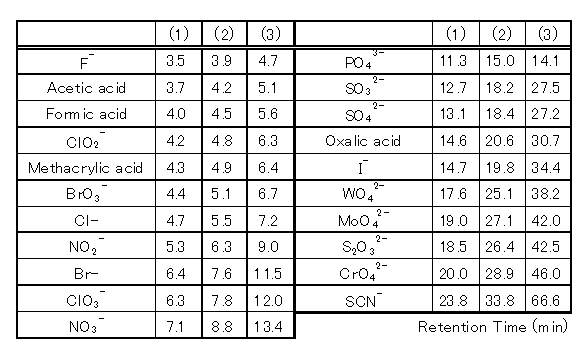
Sample :
F–
Acetic acid
Formic acid
Methacrylic acid
Cl–
NO2–
Br–
NO3–
PO43-
SO42-
Oxalic acid
I–
WO42-
MoO42-
S2O32-
CrO42-
SCN–
Column : Shodex IC SI-90 4E (4.0mmID*250mm)
Eluent : (1) 1.8mM Na2CO3 + 1.7mM NaHCO3 aq.
(2) 1.0mM Na2CO3 + 4.0mM NaHCO3 aq.
(3) 12mM NaHCO3 aq.
Flow rate : 1.0mL/min
Detector : Suppressed conductivity
Column temp. : 25deg-C
Please use this column with suppressor type ion chromatography system.
Effect of temperature on elution time when IC SI-90 4E (a column for anions analysis) is used for the analysis of anions is shown here.
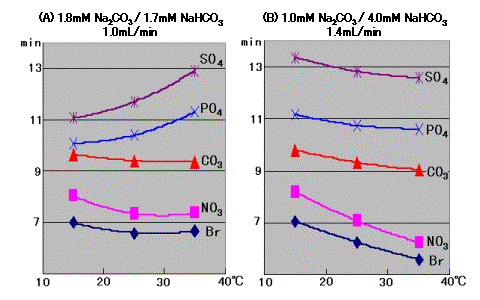
Sample :
1. Br–
2. NO3–
3. CO32-
4. PO43-
5. SO42-
Column : Shodex IC SI-90 4E (4.0mmID*250mm) Eluent : (A); 1.8mM Na2CO3 + 1.7mM NaHCO3 aq., (B); 1.0mM Na2CO3 + 4.0mM NaHCO3 aq. Flow rate : (A); 1.0mL/min, (B); 1.4mL/min Detector : Suppressed conductivity
Please use this column with suppressor type ion chromatography system.
Ion chromatography column, IC SI-90 4E was used for the quantification of several anions. Addition of acetonitrile fasten the elution of hydrophobic ions ((I– and SCN–).

Sample :
SCN–
Br–
I–
NO2–
SO42-
Cl–
PO43-
F–
NO3–
Column : Shodex IC SI-90 4E (4.0mmID*250mm) Eluent : 1.8mM Na2CO3 + 1.7mM NaHCO3 + CH3CN Flow rate : 1.0mL/min Column temp. : 25deg-C
Please use this column with suppressor type ion chromatography system.
Anion standards and organic acids were analyzed using IC SI-90 4E (a column for anions analysis).
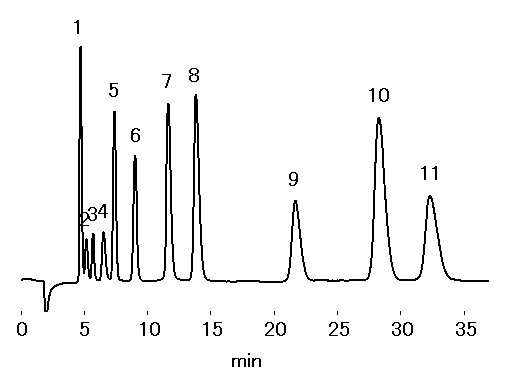
Sample : 20micro-L
1. F– 2mg/L
2. Acetic acid 10mg/L
3. Formic acid 2mg/L
4. Methacrylic acid 10mg/L
5. Cl– 3mg/L
6. NO2– 5mg/L
7. Br– 10mg/L
8. NO3– 10mg/L
9. PO43- 15mg/L
10. SO42- 15mg/L
11. Oxalic acid 15mg/L
Column : Shodex IC SI-90 4E (4.0mmID*250mm) Eluent : 12mM NaHCO3 aq. Flow rate : 1.0mL/min Detector : Suppressed conductivity Column temp. : 25deg-C
Please use this column with suppressor type ion chromatography system.
This shows the analytical conditions to separate Phosphate(HPO42-),Phosphite(HPO32-) and Hypophosphite(HPO22-) together with the seven common anions. Since the contamination of the eluent by CO2 gas shortens the retention time, it is not appropriate to prepare the eluent from the concentrate solution which easily absorbs CO2 during storage. Please be sure to prepare the eluent from the powder reagent NaHCO3 each time and limit the period of use within 12 hours.
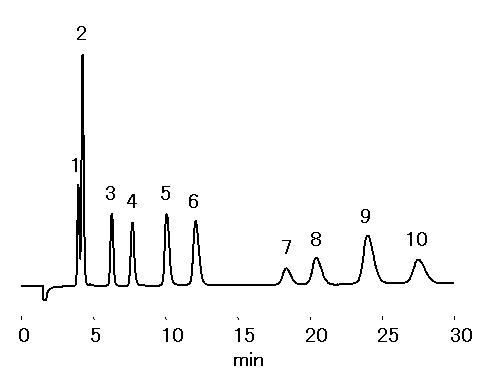
Sample : 20micro-L
1. F– 2mg/L
2. HPO22- 10mg/L
3. Cl– 3mg/L
4. NO2– 5mg/L
5. Br– 10mg/L
6. NO3– 10mg/L
7. HPO42- 15mg/L
8. HPO32- 10mg/L
9. SO42- 10mg/L
10. Oxalic acid 10mg/L
Column : Shodex IC SI-90 4E (4.0mmID*250mm) Eluent : 12mM NaHCO3 aq. Flow rate : 1.2mL/min Detector : Suppressed conductivity Column temp. : 25deg-C
Please use this column with suppressor type ion chromatography system.
Sulfite salts are widely used as a preservative for foods such as wine. Since the content of sulfite decreases with time, it is necessary to watch the content continuosly. For this purpose, suppresed ion chromatopraphy using IC SI-90 4E can be applied. Sulfite can be analyzed without the interference from organic acids contained in a large quantity in the foods, because monovalent organic acids elute mostly between F– and Cl– and divalent acids elute in the vicinity of SO42–.

Sample : Anion standards, 20mico-L
1. F– 2mg/L
2. Cl– 3mg/L
3. NO2– 5mg/L
4. Br– 10mg/L
5. NO3– 10mg/L
6. SO32- 20mg/L
7. HPO42- 15mg/L
8. SO42- 10mg/L
Sample : 20-fold diluted Red Wine, 20micro-L
2. Cl–
5. NO3–
6. SO32-
7. HPO42-
8. SO42-
Column : Shodex IC SI-90 4E (4.0mmID*250mm) Eluent : 1mM Na2CO3 + 4mM NaHCO3 + 5% Acetone Flow rate : 1.5mL/min Detector : Suppressed conductivity Column temp. : 25deg-C
Carbonate ion is contained in almost all aqueous samples and plays an important role for the ion balance. Therefore, simultaneous analysis of seven common anions (F–,Cl–, NO2–, Br–, NO3–,PO43-, SO42-) together with carbonate ion can be considered as an important target for deveolpment. Previously there have been examples of analysis including a suppressed IC method using NaOH eluent and a non-suppressed IC method using, a polymethacrylate column, but they were not satisfactory enough in peak shape, peak separation and detection sensitivity. The present method uses IC SI-90 4E and allows the baseline separation of seven common anions together with carbonate ion by non-suppressed IC using the eluent, p-hydroxybenzoic acid, pH 8.2.
(Pretreatment with the cartridges packing Na+ type cation exchange resin)
1. Rinse the cartridge with 3mL of methanol and 3mL of H2O separately.
2. Load 3mL of the sample onto the cartridge.
3. Waste 1mL of the first elution.
4. Collect 2mL of following elution.

Sample : 100micro-L each
Anion standards
1. F– 2mg/L
2. HCO3– 20mg/L
3. Cl– 3mg/L
4. NO2– 5mg/L
5. Br– 10mg/L
6. NO3– 10mg/L
7. PO43- 15mg/L
8. SO42- 15mg/L
River water (Water)
2. HCO3–
3. Cl–
4. NO2–
5. Br–
6. NO3–
7. PO43-
8. SO42-
Column : Shodex IC SI-90 4E (4.0mmID*250mm) Eluent : 5mM p-Hydroxbenzoic acid + 5.3mM N,N-Diethylethanolamine aq. Flow rate : 1.0mL/min Detector : Non-suppressed conductivity Column temp. : 25deg-C
Samples containing more than 10mg/L of Mg2+ and/or 20mg/L of Ca2+ must be pretreated, because those divalent cations form complexes with the eleuent and give rise to broad peaks which interfere with the analysis. For pretreatment,samples are passed through a pretreatment cartridge packed Na+ type cation exchange resin. This replaces the divalent cations in samples by Na+ and removes the interferring peaks.
(Pretreatment with the cartridges packing Na+ type cation exchange resin)
1. Rinse the cartridge with 3mL of methanol and 3mL of H2O separately.
2. Load 3mL of the sample onto the cartridge.
3. Waste 1mL of the first elution.
4. Collect 2mL of following elution.
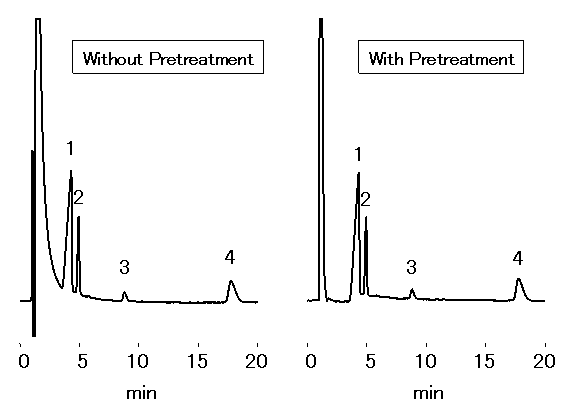
Sample : Mineral water (Water), 100micro-L
1. HCO3–
2. Cl–
3. NO3–
4. SO42-
Column : Shodex IC SI-90 4E (4.0mmID*250mm) Eluent : 5mM p-Hydroxbenzoic acid + 5.3mM N,N-Diethylethanolamine aq. Flow rate : 1.0mL/min Detector : Non-suppressed conductivity Column temp. : 25deg-C
Please use this column with suppressor type ion chromatography system.
Anion standards containing methane sulfonic acid were analyzed using IC SI-90 4E.
Sample : 20micro-L
1. F– 0.2mg/L
2. Methane sulfonic acid 10mg/L
3. Cl– 0.3mg/L
4. NO2– 0.5mg/L
5. Br– 1mg/L
6. NO3– 1mg/L
7. HPO42- 1.5mg/L
8. SO42- 1.5mg/L
Column : Shodex IC SI-90 4E (4.0mmID*250mm) Eluent : 1.8mM Na2CO3 + 1.7mM NaHCO3 aq. Flow rate : 1.0mL/min Detector : Suppressed conductivity Column temp. : 25deg-C
| Regulations for water supply introduced on April, 2004 |
||
|---|---|---|
| Item | Criteria value | Usable method |
| Nitrate nitrogen & Nitrite nitrogen |
10mg/L or less
|
Ion chromatography
|
| Fluoride |
0.8mg/L or less
|
Ion chromatography |
| Chloride |
200mg/L or less
|
Ion chromatography or Titrimetric method |
Please use this column with suppressor type ion chromatography system.
Sodium azide was analyzed using IC SI-90 4E (a column for anions analysis).
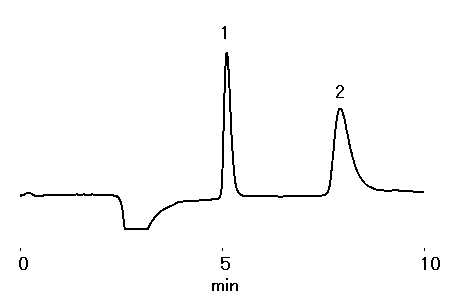
Sample : 20micro-L
1. Cl– 1mg/L
2. N3–, Azide 10mg/L
Column : Shodex IC SI-90 4E (4.0mmID*250mm) Eluent : 1.8mM Na2CO3 + 1.7mM NaHCO3 aq. Flow rate : 1.0mL/min Detector : Suppressed conductivity Column temp. : 25deg-C
Please use this column with suppressor type ion chromatography system.
Sulfamic acid was quantified using an ion chromatography column, IC SI-90 4E.
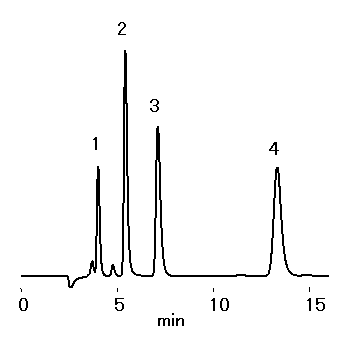
Sample : 15mg/L each, 20micro-L
1. Sulfamate (Ammonium sulfamate 15mg/L)
2. NO2– 15mg/L
3. NO3– 15mg/L
4. SO42- 15mg/L
Column : Shodex IC SI-90 4E (4.0mmID*250mm) Eluent : 1.8mM Na2CO3 + 1.7mM NaHCO3 aq. Flow rate : 1.0mL/min Detector : Suppressed conductivity Column temp. : 30deg-C
Please use this column with suppressor type ion chromatography system.
Anions in sea water were analyzed by anion-chromatography column, IC SI-90 4E Compared to chloride which is highly concentrated in sea water, concentration of nitrous acid is too low, and thus interfered by chloride ion peak to be monitored by a CD. Since nitrous, bromine, and nitrate ions have UV absorbance, they can be monitored by UV detector without being affected by chloride ion.
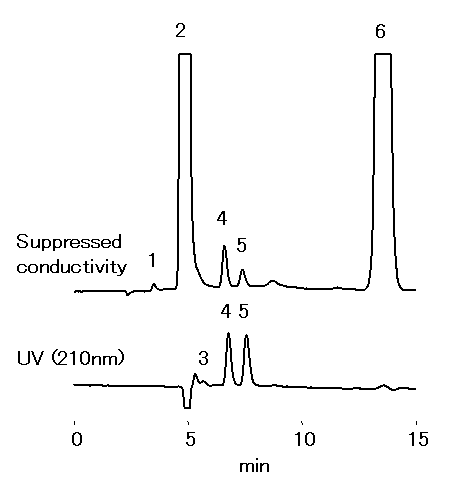
Sample : 100-fold diluted Sea water (Water), 20micro-L
1. F–
2. Cl–
3. NO2–
4. Br–
5. NO3–
6. SO42-
Column : Shodex IC SI-90 4E (4.0mmID*250mm) Eluent : 1.8mM Na2CO3 + 1.7mM NaHCO3 aq. Flow rate : 1.0mL/min Detector : Suppressed conductivity, UV(210nm) Column temp. : 25deg-C
(Shodex IC SI-50)
Please use this column with suppressor type ion chromatography system.
Anion standards and organic acids were analyzed using IC SI-50 4E (a column for anions analysis).
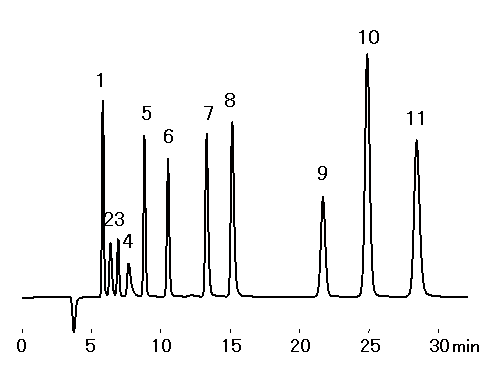
Sample : 20micro-L
1. F– 2mg/L
2. Acetic acid 10mg/L
3. Formic acid 2mg/L
4. Methacrylic acid 10mg/L
5. Cl– 3mg/L
6. NO2– 5mg/L
7. Br– 10mg/L
8. NO3– 10mg/L
9. PO43- 15mg/L
10. SO42- 15mg/L
11. Oxalic acid 15mg/L
Column : Shodex IC SI-50 4E (4.0mmID*250mm) Eluent : 3.2mM Na2CO3 + 1.0mM NaHCO3 aq. Flow rate : 0.7mL/min Detector : Suppressed conductivity Column temp. : 25deg-C
Please use this column with suppressor type ion chromatography system.
Recently ozonation has been applied for sterilization of drinking water. Ozonation transforms part of bromide to bromate which is a potential carcinogen. So, it is very important to measure bromate in drinking water. A modeldrinking water with bromate was measured by suppressed coductivity with IC SI-50 4E.
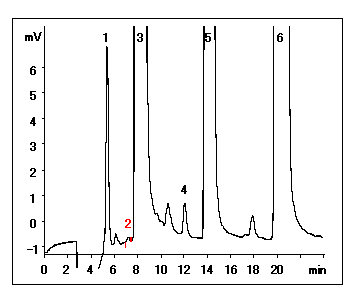
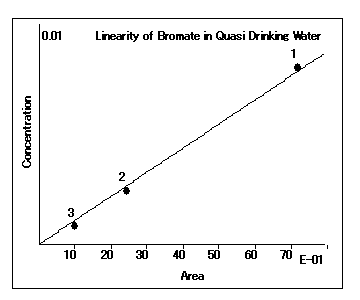
Sample : Model drinking Water, 500micro-L
1. 0.1mg/L F–
2. 0.003mg/L BrO3–
3. 20mg/L Cl–
4. 0.1mg/L Br–
5. 10mg/L NO3–
6. 10mg/L SO42-
1. : 0.02 mg/L
2. : 0.01 mg/L
3. : 0.003mg/L
Column : Shodex IC SI-50 4E (4.0mmID*250mm) Eluent : 3.2mM Na2CO3 + 1mM NaHCO3 aq. Flow rate : 0.8mL/min Detector : Suppressed conductivity Column temp. : 25deg-C
Please use this column with suppressor type ion chromatography system.
Difluoroacetic acid and Trifluoroacetic acids were analyzed using IC SI-50 4E (a column for anions analysis).
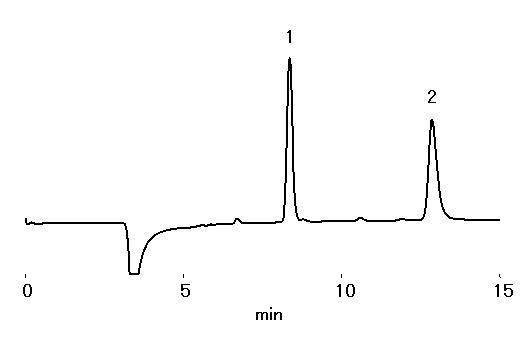
Sample : 5mg/L each, 20micro-L
1. Difluoroacetic acid
2. Trifluoroacetic acid
Column : Shodex IC SI-50 4E (4.0mmID*250mm) Eluent : 3.2mM Na2CO3 + 1mM NaHCO3 aq. Flow rate : 0.7mL/min Detector : Suppressed conductivity Column temp. : 25deg-C
(Shodex IC SI-52)
Please use this column with suppressor type ion chromatography system.
Recently ozonation has been applied for disinfection of drinking water. Ozonation transforms a part of bromide (Br–) to bromate (BrO3–), which is a potential carcinogen. Therefore, it is important to measure bromate in drinking water. IC SI-52 4E can analyze common inorganic anions and oxyhalides simultaneously with high resolution. Dichloroacetate (DCA–) as a surrogate substance is also well separated. Water dip and carbonate system peak do not overlap with other peaks.
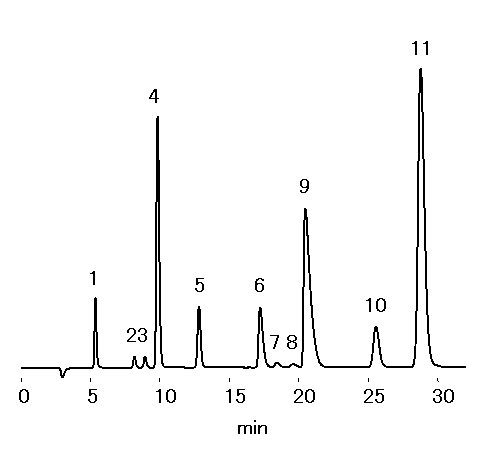
Sample : 50micro-L
1. F– (2mg/L)
2. ClO2– (1mg/L)
3. BrO3– (1mg/L)
4. Cl– (10mg/L)
5. NO2– (5mg/L)
6. Br– (10mg/L)
7. ClO3– (1mg/L)
8. DCA-, Dichloroacetate (1mg/L)
9. NO3– (30mg/L)
10. PO43- (15mg/L)
11. SO42- (40mg/L)
Column : Shodex IC SI-52 4E (4.0mmID*250mm) Eluent : 3.6mM Na2CO3 aq. Flow rate : 0.8mL/min Detector : Suppressed conductivity Column temp. : 45deg-C
Please use this column with suppressor type ion chromatography system.
In analysis using IC SI-52 4E, the retention times of some anions are very sensitive to the column temperature. An example is showed in the figure below. Usually bromide (Br–) and chlorate (ClO3–) are usually separated at 45 deg-C.
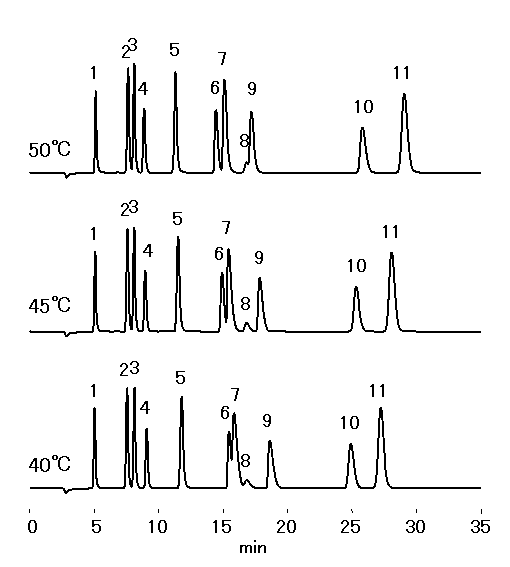
Sample : 50micro-L
1. F– (2mg/L)
2. ClO2– (10mg/L)
3. BrO3– (20mg/L)
4. Cl– (3mg/L)
5. NO2– (10mg/L)
6. Br– (10mg/L)
7. ClO3– (20mg/L)
8. DCA-, Dichloroacetate (5mg/L)
9. NO3– (30mg/L)
10. PO43- (15mg/L)
11. SO42- (40mg/L)
Column : Shodex IC SI-52 4E (4.0mmID*250mm) Eluent : 3.6mM Na2CO3 aq. Flow rate : 0.8mL/min Detector : Suppressed conductivity
Please use this column with suppressor type ion chromatography system.
By use of IC SI-52 4E, even trace level (5ppb) of oxyhalides, such as chlorite (ClO2–), bromate (BrO3–) and chlorate (ClO3–), can be determined simultaneously with seven common inorganic anions. Each calibration curve shows very good linearity over the wide range of concentration.
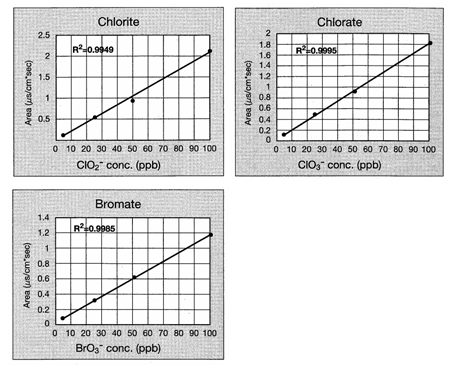
Sample : 100micro-L
ClO2–
BrO3–
ClO3–
Column : Shodex IC SI-52 4E (4.0mmID*250mm) Eluent : 3.6mM Na2CO3 aq. Flow rate : 0.8mL/min Detector : Suppressed conductivity Column temp. : 45deg-C
Please use this column with suppressor type ion chromatography system.
High resolution ion chromatography column, IC SI-52 4E was used for the quantification of several oxyhalides and organic acids. Marlic acid and succinic acid will coelute with malonic acid under this condition.
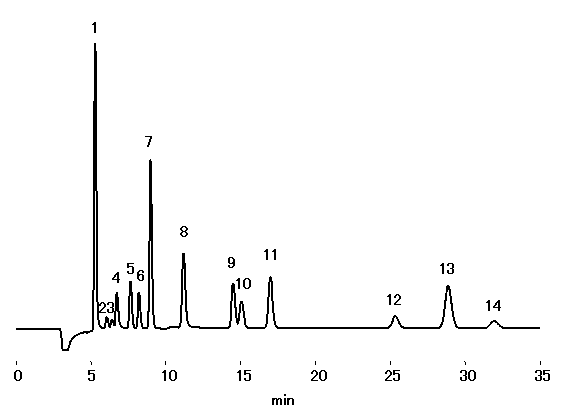
Sample : 50micro-L
1. F– 1mg/L
2. Acetic acid 0.5mg/L
3. Propionic acid 0.8mg/L
4. Formic acid 0.1mg/L
5. ClO2– 1mg/L
6. BrO3– 1mg/L
7. Cl– 1mg/L
8. NO2– 1mg/L
9. Br– 1mg/L
10. ClO3– 1mg/L
11. NO3– 1mg/L
12. PO43- 1mg/L
13. SO42- 1mg/L
14. Malonic acid 0.5mg/L
Column : Shodex IC SI-52 4E (4.0mmID*250mm) Eluent : 3.6mM Na2CO3 aq. Flow rate : 0.8mL/min Detector : Suppressed conductivity Column temp. : 45deg-C
Please use this column with suppressor type ion chromatography system.
High resolution ion chromatography column, IC SI-52 4E was used for the quantification of several oxyhalides and anions. Ethylenediamine (0.1% v/v of 50 mg/mL) is added to the water samples to prevent HCl production from the reaction between residual chloride and chlorous acid.
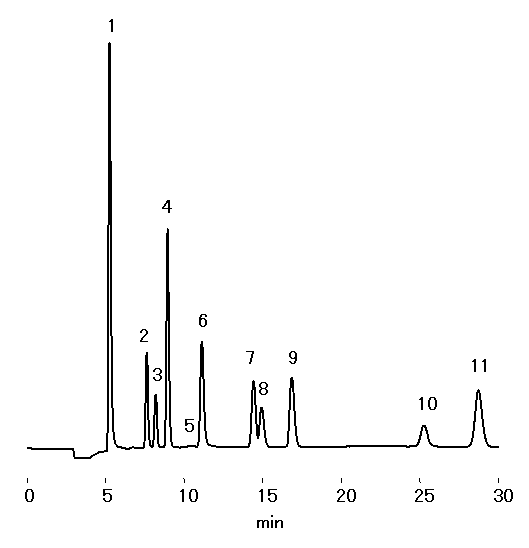
Sample : 50micro-L
Anion std. (1mg/L each) containing EDA 50mg/L
1. F–
2. ClO2–
3. BrO3–
4. Cl–
5. HCO3–
6. NO2–
7. Br–
8. ClO3–
9. NO3–
10. PO43-
11. SO42-
Column : Shodex IC SI-52 4E (4.0mmID*250mm) Eluent : 3.6mM Na2CO3 aq. Flow rate : 0.8mL/min Detector : Suppressed conductivity Column temp. : 45deg-C
Please use this column with suppressor type ion chromatography system.
Chloric acid should be analyzed by ion chromatography for water quality standard in accordance to the Ministry of Health, Labor and Welfare in Japan. Oxyhalides and anion standards in river water were analyzed using IC SI-52 4E. 1mL of Ethylendiamine (EDA) solution (50mg/mL) is to be added into 1L sample, to prevent generation of chloric acid through the reaction between chlorous acid and residual chlorine.
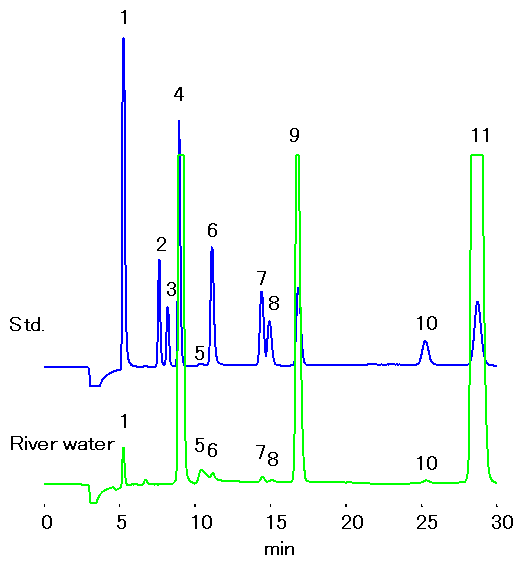
Sample : 50micro-L
Std. (1mg/L each) containing
EDA 50mg/L
Sample : 50micro-L River water (Water) containing EDA 50mg/L
1. F–
2. ClO2–
3. BrO3–
4. Cl–
5. HCO3–
6. NO2–
7. Br–
8. ClO3–
9. NO3–
10. PO43-
11. SO42-
Column : Shodex IC SI-52 4E (4.0mmID*250mm) Eluent : 3.6mM Na2CO3 aq. Flow rate : 0.8mL/min Detector : Suppressed conductivity Column temp. : 45
Please use this column with suppressor type ion chromatography system.
Chloric acid should be analyzed by ion chromatography for water quality standard in accordance to the Ministry of Health, Labor and Welfare in Japan. Oxyhalides and anion standards in river water were analyzed using IC SI-52 4E. 1mL of Ethylendiamine (EDA) solution (50mg/mL) is to be added into 1L sample, to prevent generation of chloric acid through the reaction between chlorous acid and residual chlorine.
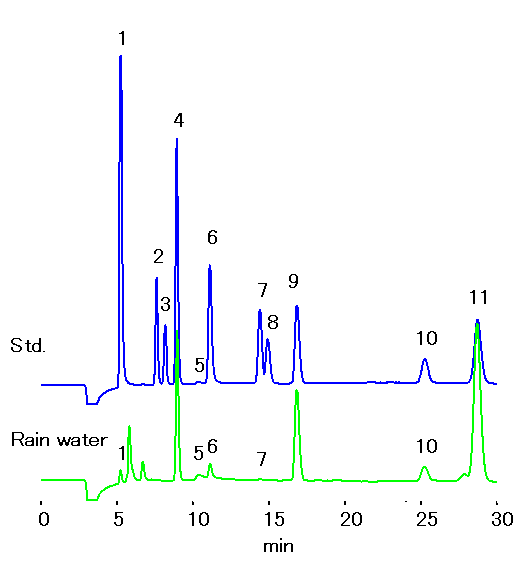
Sample : 50micro-L
Std. (1mg/L each) containing
EDA 50mg/L
Sample : 50micro-L
Rain water (Water) containing
EDA 50mg/L
1. F–
2. ClO2–
3. BrO3–
4. Cl–
5. HCO3–
6. NO2–
7. Br–
8. ClO3–
9. NO3–
10. PO43-
11. SO42-
Column : Shodex IC SI-52 4E (4.0mmID*250mm) Eluent : 3.6mM Na2CO3 aq. Flow rate : 0.8mL/min Detector : Suppressed conductivity Column temp. : 45deg-C
Please use this column with suppressor type ion chromatography system.
Chloric acid should be analyzed by ion chromatography for water quality standard in accordance to the Ministry of Health, Labor and Welfare in Japan. Oxyhalides and anion standards in river water were analyzed using IC SI-52 4E. 1mL of Ethylendiamine (EDA) solution (50mg/mL) is to be added into 1L sample, to prevent generation of chloric acid through the reaction between chlorous acid and residual chlorine.
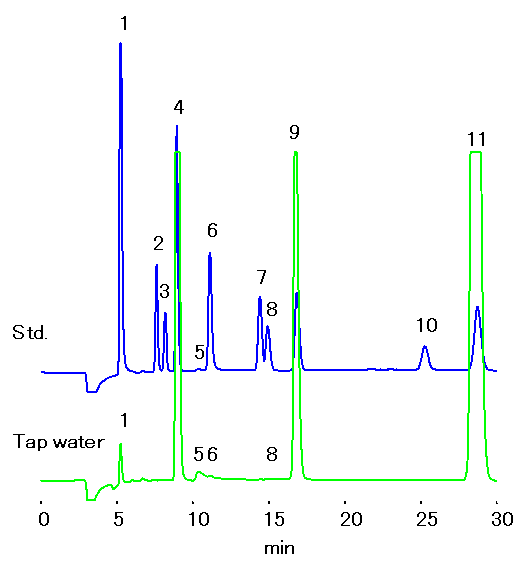
Sample : 50micro-L
Std. (1mg/L each) containing
EDA 50mg/L
Sample : 50micro-L
Tap water (Water) containing
EDA 50mg/L
1. F–
2. ClO2–
3. BrO3–
4. Cl–
5. HCO3–
6. NO2–
7. Br–
8. ClO3–
9. NO3–
10. PO43-
11. SO42-
Column : Shodex IC SI-52 4E (4.0mmID*250mm) Eluent : 3.6mM Na2CO3 aq. Flow rate : 0.8mL/min Detector : Suppressed conductivity Column temp. : 45deg-C
Please use this column with suppressor type ion chromatography system.
High performance anion chromatography column, IC SI-52 4E was used to analyze oxyhalides including iodic acid.
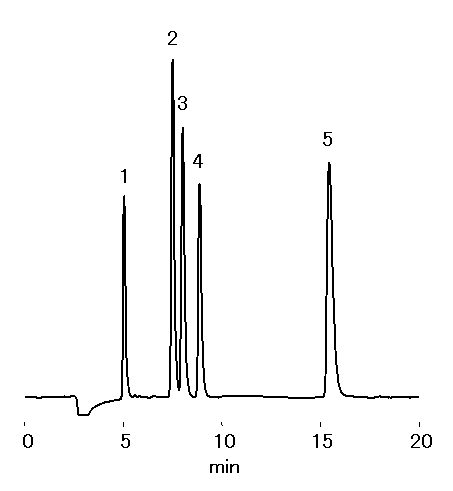
Sample : 50micro-L
1. IO3– (5mg/L)
2. ClO2– (3mg/L)
3. BrO3– (5mg/L)
4. Cl– (1mg/L)
5. ClO3– (5mg/L)
Column : Shodex IC SI-52 4E (4.0mmID*250mm) Eluent : 3.6mM Na2CO3 aq. Flow rate : 0.8mL/min Detector : Suppressed conductivity Column temp. : 45deg-C
(Shodex IC SI-91)
Oxyhalides in mineral water were analyzed with IC SI-91 4C according to Guideline 101, the Ministry of Health, Labour and Welfare, Japan.
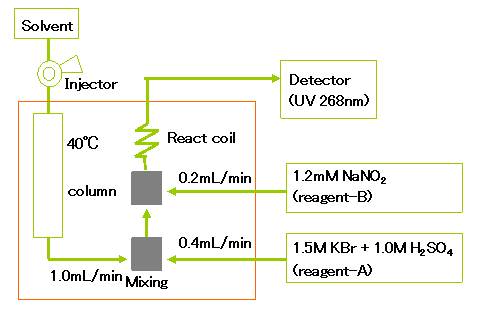

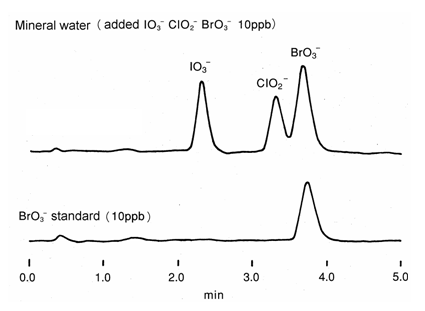
Sample : 200micro-L
Mineral water (Water), BrO3– standard
IO3–
ClO2–
BrO3–
Column : Shodex IC SI-91 4C (4.0mmID*100mm)
Eluent : 1.8mM Na2CO3 + 1.7mM NaHCO3 aq.
Reagent A : 1.5M KBr + 1.0M H2SO4 aq.
Reagent B : 1.2mM NaNO2 aq.
Flow rate : (Eluent); 1.0mL/min
(Reagent A); 0.4mL/min
(Reagent B); 0.2mL/min
Detector : UV(268nm)
Oxyhalides in tap water were analyzed with IC SI-91 4C according to Guideline 101, the Ministry of Health, Labour and Welfare, Japan.


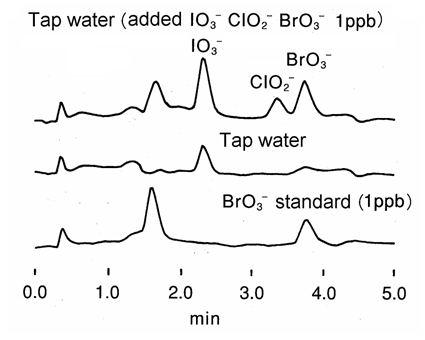
Sample : 200micro-L
Tap water (Water), BrO3– standard
IO3–
ClO2–
BrO3–
Column : Shodex IC SI-91 4C (4.0mmID*100mm)
Eluent : 1.8mM Na2CO3 + 1.7mM NaHCO3 aq.
Reagent A : 1.5M KBr + 1.0M H2SO4 aq.
Reagent B : 1.2mM NaNO2 aq.
Flow rate : (Eluent); 1.0mL/min
(Reagent A); 0.4mL/min
(Reagent B); 0.2mL/min
Detector : UV(268nm)
(Shodex WINE VH-anion 4D)
Please use this column with suppressor type ion chromatography system.
WINE VH-anion 4D was used to quantify anions in wine standard. VH-anion 4D provides a rapid analysis without any influence from organic acid present in wine. This method using VH-anion 4D for the quantification of anions in wine was co-developed with Institute Heidger (Kesten, Germany). *The wine standard is prepared artificially that contains components that are generally present in wine and commercially available from an institute in Speyer, Germany.
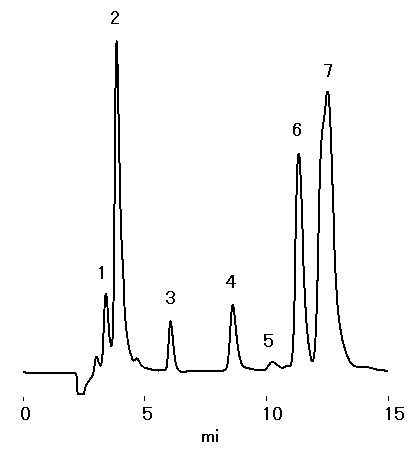
Sample : 50-fold diluted Wine standards, 20micro-L
1. F–
2. Lactic acid
3. Cl–
4. PO43-
5. SO32-
6. SO42-
7. Tartaric acid, Malic acid
Wine Standard
| Component | Concentration Original Sample |
Concentration (1+49) Diluted Sample |
|---|---|---|
| F– |
unknown
|
unknown
|
| Cl– |
66.9mg/L
|
1.338mg/L
|
| PO43- |
570.7mg/L
|
11.414mg/L
|
| SO32- |
27.1mg/L
|
0.542mg/L
|
| SO42- |
219.4mg/L
|
4.388mg/L
|
| Lactic acid |
2.062g/L
|
41.24mg/L
|
| Tartaric acid |
2.79g/L
|
55.8mg/L
|
| Malic acid |
3.721g/L
|
74.42mg/L
|
Column : Shodex WINE VH-anionG 4A (4.6mmID*10mm) + WINE VH-anion 4D (4.6mmID*150mm) Eluent : 5mM Na2CO3 + 12mM NaHCO3 + 3% Acetone Flow rate : 0.8mL/min Detector : Suppressed conductivity Column temp. : 30deg-C
Please use this column with suppressor type ion chromatography system.
WINE VH-anion 4D was used to quantify anions in wine. VH-anion 4D provides a rapid analysis without any influence from organic acid present in wine. Malo-lactic fermentation used during wine manufacturing makes malic acid into lactic acid. By using VH-anion 4D wine analysis method, the degree of malo-lactic fermentation can be also monitored.
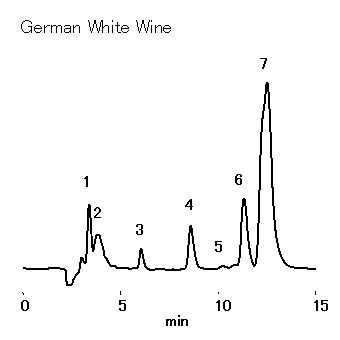
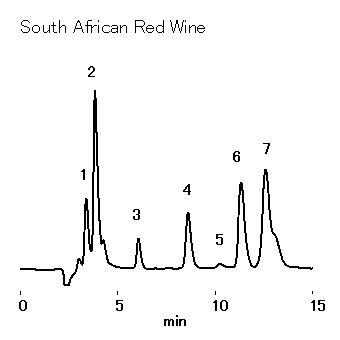
Sample : 50-fold diluted Wine, 20micro-L
1. F–
2. Lactic acid
3. Cl–
4. PO43-
5. SO32-
6. SO42-
7. Tartaric acid, Malic acid
Columns : Shodex WINE VH-anionG 4A (4.6mmID*10mm) + WINE VH-anion 4D (4.6mmID*150mm) Eluent : 5mM Na2CO3 + 12mM NaHCO3 + 3% Acetone Flow rate : 0.8mL/min Detector : Suppressed conductivity Column temp. : 30deg-C
